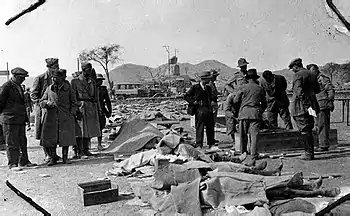Gondrand massacre
The Gondrand massacre was a 1936 Ethiopian attack on Italian workers of the Gondrand company. It was publicized by Fascist Italy in an attempt to justify its ongoing conquest of Ethiopia.[1][2][3]

History
The Gondrand massacre occurred on February 13, 1936, near the northern Ethiopian town of Mai Lahlà.[3][4] A camp of civilian workers for the logistics company Gondrand, engaged at the time in road construction, was attacked at dawn by Ethiopian soldiers under the orders of Ras Imru.[3] The construction yard was equipped with about 15 muskets, and the workers also used their work tools as defense weapons, but they were overwhelmed by the surprise attack of the Ethiopians.
The massacre took place around the same time as the Battle of Amba Aradam, fought from 10 to 19 February 1936, about 200 kilometres (120 mi) south of Mai Lahlà.[5]
Casualties
Of the 130 Italian workers present, 80 were killed, and the bodies of 17 of them were castrated in contravention of Ethiopian Emperor Haile Selassie's explicit order not to mutilate enemy corpses.[2] 27 others were wounded and four went missing.[2] Of these, three were later confirmed to have been taken prisoner.[2]
About 40 Ethiopians soldiers also died in the attack, mostly because a store of gelignite exploded.[3] Retaliatory massacres were carried out by Italian soldiers against Ethiopian civilians in the aftermath of the attack, resulting untold deaths.[3][6]
Publicity
Italian authorities generally instructed journalists to avoid describing Italian losses during the war, but in this case the story was deliberately promoted for its propaganda value in depicting Ethiopians as barbaric.[1][3] As professor of Italian studies David Forgacs argues, while "the Italians sought to give maximum publicity to the massacre of Italian civilians by Ethiopians at the Gondrand camp they were equally strenuous in their efforts to prevent records or reports of their own massacres of civilians".[3]
In response to photographic evidence that some Ethiopian troops had ignored the order against mutilating corpses, Ethiopia's Foreign Minister was forced to admit that it had happened, but argued that it should be seen as an act of protest against Italian atrocities.[2] Historian Rainer Baudendistel argues that such mutilation "was a limited phenomenon successfully blown out of proportion by adroit Italian propaganda."[2]
Notes
- Andreani, Marco; Pazzaglia, Nicoletta (2019). Photography as Power: Dominance and Resistance through the Italian Lens. Cambridge Scholars Publishing. pp. 83–86. ISBN 1527524884.
- Baudendistel, Rainer (2006). Between Bombs and Good Intentions: The International Committee of the Red Cross (ICRC) and the Italo-Ethiopian War, 1935-1936. Oxford and New York: Berghahn Books. pp. 242–246. ISBN 1782388729.
- Forgacs, David (2014). Italy's Margins: Social Exclusion and Nation Formation since 1861. Cambridge University Press. pp. 123–127. ISBN 1139868144.
- History Revealed: Collection of 22 photos of the Gondrand Massacre
- Barker, A. J. (1971). Rape of Ethiopia, 1936. New York: Ballantine Books. pp. 80–81. ISBN 0345024621.
- Marrocu, Luciano (2015). Novelli, Cecilia Dau; Farnetti, Paolo Bertella (eds.). Flaiano in Africa: A Rare Example of Lucidity. Colonialism and National Identity. Cambridge Scholars Publishing. p. 97. ISBN 1443881260.
